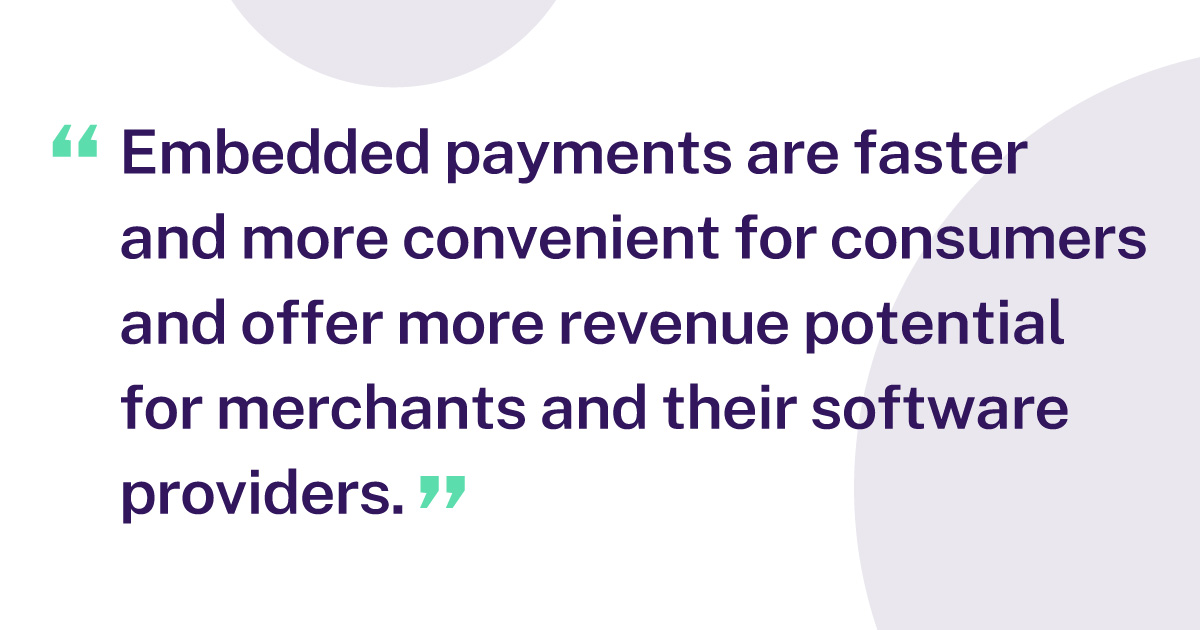Embedded payments are taking over the digital payments space one app at a time, and they’re quickly becoming a must-have feature for independent software vendors (ISVs). Embedded payments – payment systems built natively into software applications – enable users to make payments without being redirected to an outside or third-party site.
That simplified process offers a variety of benefits, including:
- Improved convenience and user experience
- Stickier, more loyal users
- Heightened perception of trust and security
- Enhanced control for ISVs
- Faster, more streamlined payments
Opportunities to provide passthrough payment processing for merchant users
Embedded payments are everywhere. Anyone who’s ever called an Uber, signed up for a streaming service like Netflix or Spotify or made an in-game purchase has already used embedded payments. They’ve become so ubiquitous that users now expect them.
Despite being so ingrained in our daily lives, embedded payments are still growing. Bain & Company projects that the B2B embedded payments market will quadruple to $2.6 trillion in transaction value and $6.7 billion in revenues by 2026. In addition, Juniper Research estimates that revenue generated by embedded payments will top $59 billion by 2027 – 84% higher than today.
In short, consumer preferences are changing – especially among younger demographics. That change is driving a shift towards simple, integrated payment systems to the extent that, by 2030, 74% of consumer payments will go through non-traditional service providers.
For software vendors looking to scale up their platforms, unlock new revenue channels and enhance the customer experience, there is no better time to get ahead of this revolutionary trend.
What are Embedded Payments, and Why Are They Important for ISVs?
The idea behind embedded payments is simple – electronic payment processing built directly into a software application removes friction from the payment process. It allows customers to make payments in the software itself without being redirected to a third-party platform.
For example, a user looking to upgrade to a premium software subscription should be able to do that mid-use (ideally in a few clicks) without having to leave the application. In this case, paying should be all but invisible to the user – just another part of whatever application they’re using.
Embedded payments are faster and more convenient for consumers and offer more revenue potential for merchants and their software providers.
The Benefits of Embedded Payments at Each Level of the Payments Chain
Just as streamlined, reliable point of sale (POS) functionality is necessary for traditional brick-and-mortar merchants, embedded payments are a must-have for software vendors. In addition to providing a competitive market advantage, embedded payments offer a variety of benefits to everyone in the payments chain – consumers, merchants and ISVs.
How Do Embedded Payments Benefit Consumers?
One of the most important benefits to end users is speed and convenience. Embedded payments eliminate the need for users to be redirected to an external payment portal (or, worse, leave the app, fire up a browser and search for an alternate payment option). A simplified, integrated checkout saves users time and improves the quality of their experience.
Embedded payments also offer users a feeling of security that a portal redirect can’t. Less tech-savvy users may find redirection through a portal jarring, especially if another company’s brand is featured on the checkout page. Digitally native Gen Z consumers, who have grown up with smart devices and apps in their hands, may find payment redirects archaic, undermining their confidence in a software vendor. Instead, embedded payments offer the smooth, secure payment experience modern consumers demand.
How Do Embedded Payments Benefit Merchants?
The best software solutions allow businesses to manage their operations and sell to customers directly through the platform. However, in most cases, software platforms require merchants to access payment processing through a third party – an inefficient and unneeded extra step. Even if a solution has rudimentary payment options, most do not offer the innovative features and flexibility merchants require.
Today, forward-thinking ISVs use embedded payments as a launching point to offer value-added services to merchants through their platform. By partnering with a full commerce enablement platform to add embedded payments to their native software, developers can provide merchants with a one-stop business solution that includes:
- Advanced Merchant Onboarding: Merchants can get up and running with accepting payments quickly from right within the software itself, saving them time, money and the headache of juggling another vendor just for processing
- Greater Customer Experience: Because embedded payments are so much safer and more convenient for consumers, they make it easier for merchants to retain customers and grow their business
- Enhanced Security: Embedded payments provide greater security, with some solutions offering advanced, AI-powered fraud detection and prevention
- Recurring Payments: With embedded payments, merchants can easily enable recurring payments, allowing them to capture more revenue and streamline the customer experience

How Do Embedded Payments Benefit Software Providers?
In addition to improving the merchant and customer payment experiences, embedded payments allow software providers to generate more revenue by monetizing transactions and positioning their platform as a convenient, one-stop merchant solution.
Consumers don’t want to be redirected to an external site to make payments. By allowing them to transact natively, merchants can improve the overall checkout experience, helping foster loyalty and offering a heightened feeling of security among their customers. That means software developers who offer embedded payments will have sticker, longer-lasting customers.
Depending on their payments provider, ISVs will also have the chance to earn residual revenue on each transaction that passes through their platform. Developers can incorporate their own branding and set their own prices – giving them complete control over every aspect of their in-app solutions.
The payment process itself is similar to traditional digital payments. Software providers will have a merchant or sub-merchant account, a relationship with a payment processor and access to value-added services like anti-fraud tools. The key difference is that, in an embedded scenario, the ISV’s payment gateway is built directly into their software rather than a standalone ecommerce site.
Getting Setup with Embedded Payments
The technicalities behind payment processing, such as payment security and government compliance, make it challenging for software vendors to develop embedded payment functionality in-house.
For ISVs offering direct payment services to merchants, finding processing partners, onboarding and underwriting users and enabling value-added services like fraud protection can feel overwhelming.
In the past, these challenges were significant enough to keep ISVs from integrating payments altogether. Today, however, full commerce enablement platforms like NMI make it easy to access and integrate everything needed to take advantage of embedded payments.
When shopping around for a new payments system, look for a partner that offers:
- An easily-integrated, user-friendly payment gateway
- Access to as many payment processors as possible
- Advanced security and fraud prevention systems
- Easy KYC and anti-money laundering (AML) checks
- The ability to easily resell payment services to business users
- Automated onboarding and underwriting tools
- A full suite of value-added services that can be upsold to business users
- PCI Level 1 compliance
- Industry-leading support and expertise, especially in areas like security and regulatory compliance
Whether you want to simply accept embedded payments or build a complete payments service to resell to business users, NMI has the technology and expertise necessary to get you there quickly.
To learn more about how NMI’s full commerce enablement solutions can take your payments to the next level, reach out to a member of our team today.




